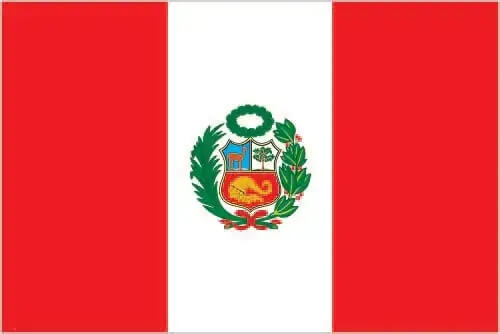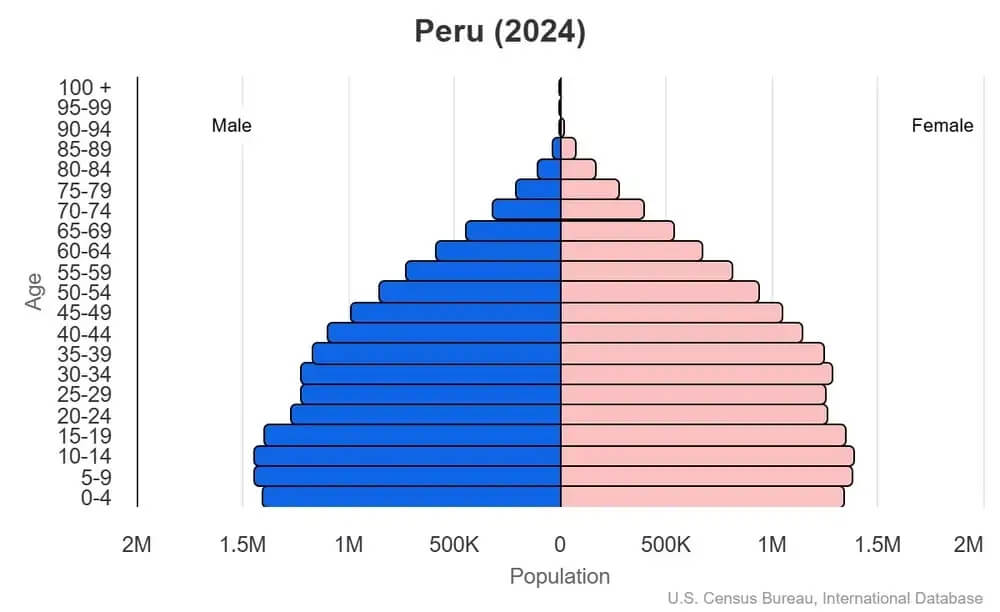World Book
Peru
World Book Index
69


With a score of 69, the country is ranked 68th out of 158 countries in the World Book ranking. (more information)
Introduction
Background
Ancient Peru was the seat of several prominent Andean civilizations, most notably that of the Incas whose empire was captured by Spanish conquistadors in 1533. Peru declared its independence from Spain in 1821, and remaining Spanish forces were defeated in 1824. After a dozen years of military rule, Peru returned to democratic leadership in 1980.
Geography
Area
total : 1,285,216 sq km
land: 1,279,996 sq km
water: 5,220 sq km
Climate
varies from tropical in east to dry desert in west; temperate to frigid in Andes
Natural resources
copper, silver, gold, petroleum, timber, fish, iron ore, coal, phosphate, potash, hydropower, natural gas
People and Society
Population
total: 32,600,249 (2024 est.)
Ethnic groups
Mestizo (mixed Indigenous and White) 60.2%, Indigenous 25.8%, White 5.9%, African descent 3.6%, other (includes Chinese and Japanese descent) 1.2%, unspecified 3.3% (2017 est.)
Languages
Spanish (official) 82.9%, Quechua (official) 13.6%, Aymara (official) 1.6%, Ashaninka 0.3%, other native languages (includes many minor Amazonian languages) 0.8%, other 0.2%, none 0.1%, unspecified 0.7% (2017 est.)
Religions
Catholic 76%, Evangelical Christian 15.7%, no religion 5.1%, other religions 3.2% (2023 est.)
Population growth rate
0.48% (2024 est.)
Government
Government type
presidential republic
Capital
name: Lima
Executive branch
chief of state: President Dina Ercilia BOLUARTE Zegarra (since 7 December 2022)
head of government: President Dina Ercilia BOLUARTE Zegarra (since 7 December 2022)
Diplomatic representation in the US
chief of mission: Ambassador Alfredo Santiago Carlos FERRERO DIEZ CANSECO (since 27 February 2024)
Diplomatic representation from the US
chief of mission: Ambassador (vacant); Chargé d’Affaires Joan PERKINS (since 18 April 2025)
Economy
Economic overview
upper-middle-income South American economy; strong post-COVID rebound tempered by political uncertainty and climate risks; exports driven by mineral extraction and agriculture; large informal sector and uneven access to public services; stable fiscal position and financial sector
Real GDP (purchasing power parity)
$535.911 billion (2024 est.)
$518.771 billion (2023 est.)
$520.872 billion (2022 est.)
Real GDP per capita
$15,700 (2024 est.)
$15,300 (2023 est.)
$15,600 (2022 est.)
Exports
$83.325 billion (2024 est.)
$72.97 billion (2023 est.)
$71.39 billion (2022 est.)
Exports - partners
China 34%, USA 14%, Canada 5%, India 4%, Switzerland 4% (2023)
Exports - commodities
copper ore, gold, refined copper, refined petroleum, grapes (2023)
Imports
$67.16 billion (2024 est.)
$63.776 billion (2023 est.)
$69.936 billion (2022 est.)
Imports - partners
China 26%, USA 21%, Brazil 7%, Argentina 5%, Mexico 3% (2023)
Imports - commodities
refined petroleum, crude petroleum, cars, trucks, broadcasting equipment (2023)
Human Development Index
The country's Human Development Index (HDI) is 0.794, ranking it 79th out of 193 countries tested. (more information)
World Happiness Report
The World Happiness Report ranked the country 65th out of 158 countries tested with a score of 5.959. (more information)



